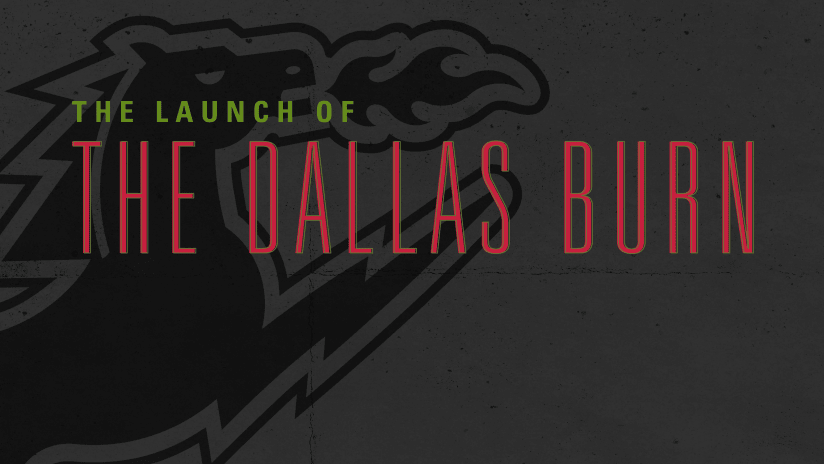Story updated June 5, 2023
FRISCO, Texas – It’s been 27 years since the Dallas Burn played its inaugural game and helped Major League Soccer kick off a new era in American soccer history.
The Burn’s first game – played against the San Jose Clash in the Cotton Bowl on April 14, 1996 – was the culmination of a whirlwind planning process; and ended a 15-year wait for the return of pro soccer in Dallas.
Dallas was the last city awarded an MLS franchise in 1995, and one of three league-owned teams. The late start meant the club’s front office didn’t form until fall of ’95, giving them just a few months to launch the new team.
“It was an accelerated process to get everything in place to actually put on opening day in 1996,” says Andy Swift, who was hired as the Burn’s first Director of Community Relations and Hispanic Media.“I think the lease on the Cotton Bowl wasn’t signed until the night before, which goes to show how quick the process was for us compared to the other teams in the league.”

The short turnaround meant the Burn’s 20-person front office had to work around the clock to get the club off the ground for the big day. Swift, who’d go on to become the club’s president and general manager, remembers a unique feeling among the stuff.
“It was fun, we all had a pioneer spirit because we knew we were kicking off something new,” he recalled. “But there was uncertainty, ‘What’s opening day going to look like? Are we going to open the gates and is anyone going to show up?’”
When the Cotton Bowl’s gates first opened that Sunday afternoon in April, Swift’s fears were instantly quelled. People showed up; 27,779 of them to be exact.
“It’s a number I remember to this day,” Swift said. “Because it was many more than we expected.
“The attendance really made for an exciting day. It validated everything we’d been doing up until that point in terms of marketing and branding the team.”

The makeup of the crowd that day was a direct reflection of Burn's marketing strategy. As Swift explains, Burn GM Billy Hicks and marketing manager Paul Phipps aimed much of team’s advertising efforts towards Dallas’ Hispanic and youth soccer populations.
The Hispanic market, in particular, was an easier sell as Mexican forward Hugo Sanchez – a World Cup veteran and five-time Pichichi winner – made headlines as the club’s first player. Fellow Latin-American stars Diego Soñora and Leonel Álvarez (who both started the inaugural game) only added to the Burn’s appeal.

“Having them in market was key because it allowed us go to into the [Hispanic] community on radio and television with [the players] as spokespeople to help us create awareness,” Swift added. “They were vital in helping us generate interest in the Hispanic community.”
Leadership’s hunch was right, and the city’s Hispanic community showed up en masse on opening day. Swift remembers the club sold nearly 10,000 tickets just on game day—an indication that their Hispanic outreach was working.
“We found that the walk-up attendance was a direct barometer of the Hispanic interest,” he explained. “Because that consumer was more of a day-of-game ticket purchaser—at least at that time.
“So, it was opening day that we realized ‘Oh man, we’ve really made inroads with the Hispanic community.’”
The front office’s other focus – the youth soccer market – was more by necessity than design. Although it had undergone renovations, the Cotton Bowl was originally built in 1930 and lacked the luxury suites and other amenities that drive corporate ticket sales. Instead, the Burn looked to group sales and Dallas’ youth soccer population; a decision which paid as they sold the fifth most group tickets in MLS's first season.
While the Cotton Bowl may not have appealed to Dallas’ corporate bigwigs, the same cannot be said for the players. The stadium was known as a former World Cup venue and its playing surface was unmatched in the league at the time. “Year in and year out, the field was voted by MLS and the players as the best surface of any at the time,” Swift remembers.
With the ink still drying on the stadium lease, the Burn was finally ready to introduce itself to the city. Sunday, April 14, 1996 marked a new chapter in Dallas’ soccer story.
“[That game] was extremely important in many regards,” Swift said. “Right away, it showed there’s a consumer here for the game. It also gave everyone working on it on the confidence that ‘we can do this’, especially here in Dallas because we were put together last minute. The fact that we were able to put that off and put on a good show opening day gave us confidence going forward. Also, we won the game and that’s always important.”





